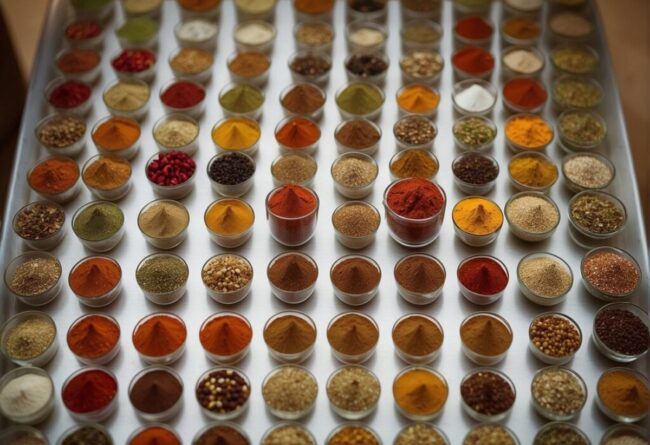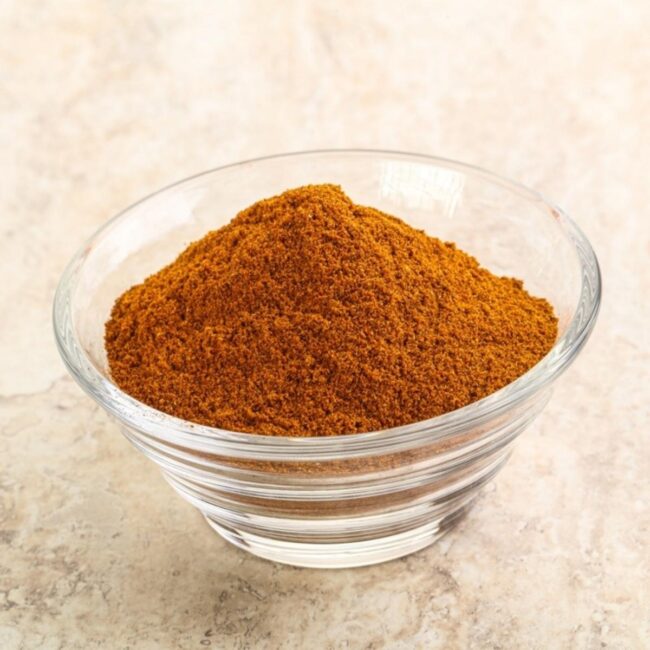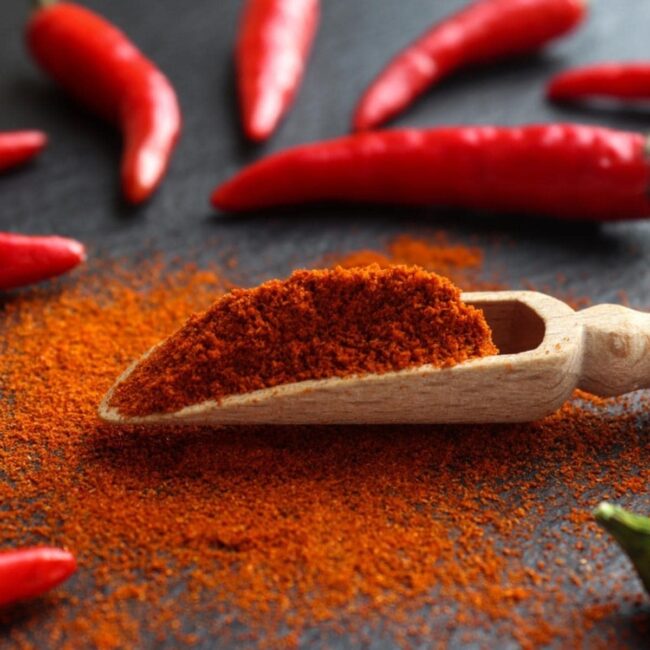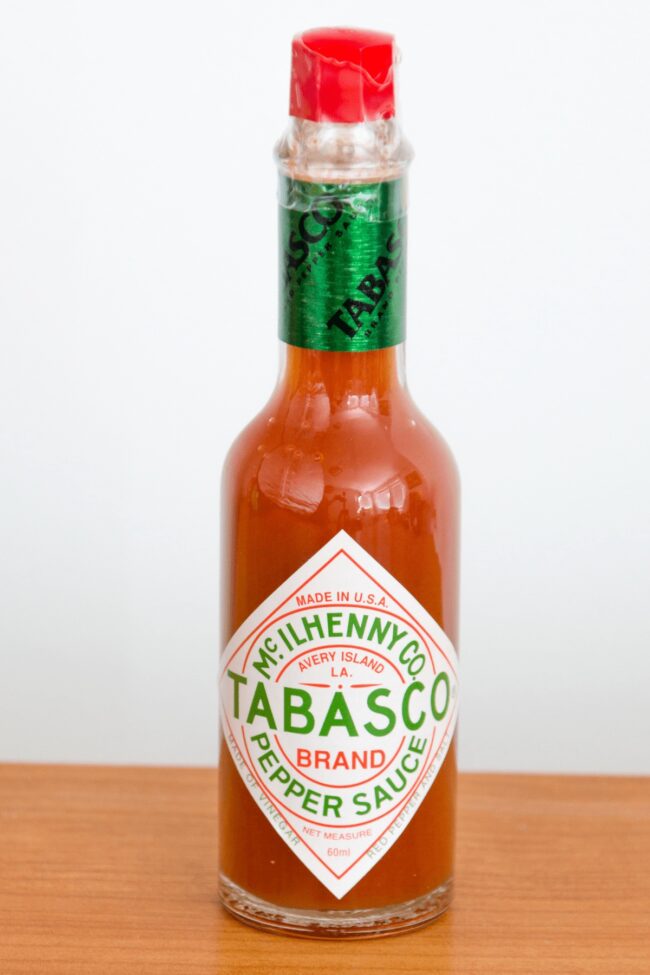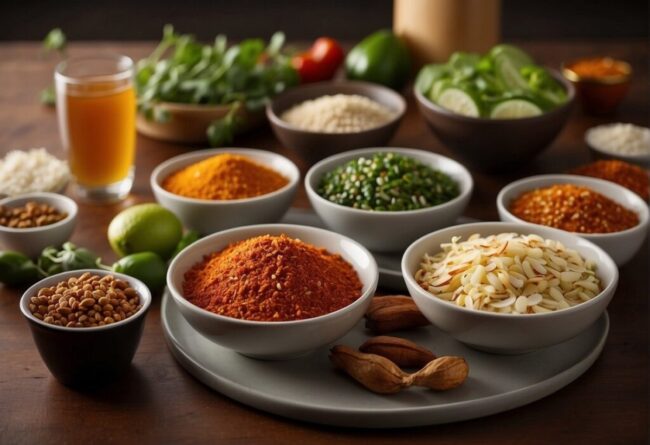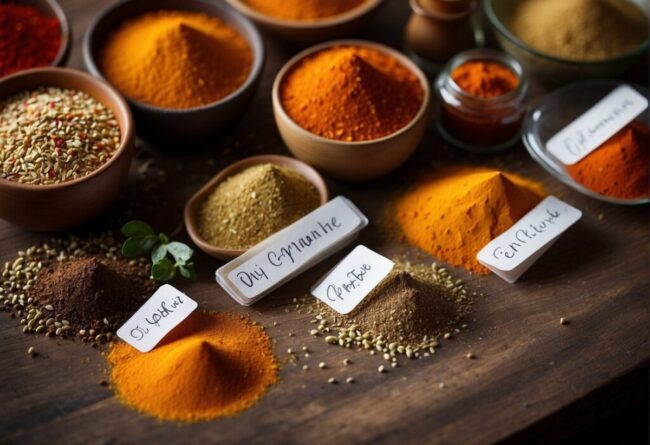7 Bold Swaps for Cayenne Pepper in Recipes
Cayenne pepper substitutes add a spark of heat and color when that fiery kick is absent.
A variety of zesty alternatives delivers a punch that enlivens stews and sauces with vibrant intensity.
Dishes brim with a lively energy that excites the taste buds and enlivens every bite.
A spirited replacement ensures your creations stay lively and bright.
Understanding Cayenne Pepper
Cayenne pepper, a vibrant red chili from the Capsicum annuum family, finds its roots in Cayenne city in French Guiana.
Known for its sharp and pungent flavor, this pepper enhances dishes with both heat and taste.
Typically measured on the Scoville scale, cayenne ranks between 30,000 to 50,000 heat units.
Available fresh or as dried powder, it offers varying levels of spice suitable for many recipes.
Beyond cooking delights, cayenne is also believed to help boost metabolism and curb appetite.
Caution is wise when using this spice; starting with a small amount allows you to adjust according to your personal preference for heat.
Ideal Cayenne Pepper Swaps Based on Heat Level
Whether you're seeking a milder spice or an extra fiery substitute, these ideal swaps offer customizable options to suit your culinary needs.
Mild Heat Alternatives
Paprika serves as a fantastic alternative, offering a rich red hue that can brighten up your dishes without overwhelming the palate.
This spice, made from sweet or smoked peppers, enhances flavor while keeping things mild.
Red pepper flakes present another option with their vibrant color and subtle kick; they add texture and warmth to recipes without overpowering other ingredients.
The combination of these substitutes creates depth in meals while allowing you to control the heat level effectively.
Perfect for those who appreciate flavor over fire, these spices can elevate your cooking effortlessly.
Ideal Cayenne Pepper Swaps
Whether you're seeking a milder spice or an extra fiery substitute, these ideal swaps offer customizable options to suit your culinary needs.
Moderate Heat Alternatives
Hot sauce adds a kick without overwhelming the palate.
Its liquid form blends easily into sauces, soups, and marinades.
Jalapeño pepper powder introduces a moderate heat level that complements various recipes beautifully.
You can sprinkle it on tacos or mix it into stews for that extra zing.
Both options provide flavorful alternatives while maintaining a pleasant balance in your dishes.
Hot Cooking Alternatives
Chili powder offers a versatile alternative, often providing a milder kick but with specific blends that can mimic cayenne's intensity.
Gochugaru stands out for its vibrant flavor and heat, bringing an exciting twist to dishes while maintaining the desired spiciness.
Both options allow you to experiment in the kitchen without sacrificing taste.
You might discover that these substitutes add their own unique flair to your meals.
Next time you're cooking, consider reaching for one of these alternatives instead of cayenne; they could surprise you with their depth and character.
Specific Substitutes
Here are some specific ingredients to replace cayenne pepper that you can try in your recipes.
Types of Paprika
Paprika adds a colorful flair to dishes while enhancing their flavor profile.
Sweet paprika provides a gentle touch, perfect for those who favor milder tastes in their cooking.
Hot paprika delivers more intensity, making it an excellent alternative to cayenne pepper for those seeking a kick.
Smoked paprika introduces an earthy richness that can elevate everything from stews to grilled meats.
Experimenting with different types opens up exciting new dimensions in your culinary adventures; don't hesitate to try them all!
Chili and Chili Powder
Chili adds depth and flavor to countless dishes, showcasing its versatility.
Red chili flakes introduce a coarse texture with just the right amount of heat, perfect for those who prefer milder spice levels.
Chili powder combines various spices for a balanced taste that enhances stews and sauces without overwhelming them.
Chipotle powder brings a unique smoky essence that elevates any meal, transforming ordinary ingredients into something special.
Choosing the right type can elevate your cooking experience and inspire creativity in the kitchen.
Hot Sauce Choices
Hot sauces offer a flavorful alternative to cayenne, each bringing its own unique character.
Tabasco sauce stands out with its sharp and tangy profile, making it a favorite for those who appreciate a zesty kick.
Serrano pepper-based sauces deliver an invigorating heat that’s bolder than jalapeño options, adding brightness to dishes without overwhelming the palate.
Exploring different varieties can enhance your culinary creations in exciting ways.
Why settle for one flavor when an entire world of spice awaits?
More Spicy Options
Substituting cayenne pepper opens up a world of flavor.
Fresh Thai peppers pack a punch, so use them carefully to match your heat preference.
Jalapeño powder offers a milder kick, adding depth without overwhelming the dish.
Gochugaru introduces an earthy sweetness with its vibrant flakes, perfect for Korean-inspired meals.
Always begin with small quantities of these alternatives and adjust as needed to find that ideal balance in your cooking.
How to Use Cayenne Pepper in Cooking
Cayenne pepper adds heat and a touch of smokiness to dishes. It is commonly used in soups, marinades, and spice blends for extra flavor.
Types of Meats
Cayenne pepper elevates meat dishes with a bold kick that perfectly balances savory flavors.
Just a quarter teaspoon added to beef brings out an exciting warmth, enhancing every bite.
For chicken, a light dusting creates an enticing crust, adding depth without overwhelming the palate.
Mixing cayenne with brown sugar for pork offers an intriguing blend of spice and sweetness that tantalizes taste buds.
Exploring these combinations opens up new dimensions in your cooking adventures.
Soups and Stews
Cayenne pepper adds an exciting kick to soups and stews, enhancing flavors in a delightful way.
A little goes a long way, so starting small allows you to customize the heat according to your taste preferences.
In chili, just a dash brings out rich complexity without overwhelming the dish.
For broth-based soups, incorporating cayenne during simmering infuses warmth throughout each bowl.
Creamy soups benefit from mixing in cream or yogurt; this combination balances out the spiciness beautifully while maintaining a velvety texture.
Flavorful Mixes and Dips
Cayenne pepper adds an unexpected kick to your culinary creations, transforming the ordinary into something memorable.
When combined with acidic ingredients like lemon juice or vinegar in marinades, it creates a zesty flavor profile that lingers on the palate.
A sprinkle in tomato-based sauces elevates their richness while introducing a warm heat that dances on your taste buds.
Mixing cayenne into salsa can turn up the flavor notch; pairing it with sweet fruits like mango or pineapple offers an exciting contrast that surprises and delights.
This versatile spice opens doors to new taste experiences you might not have considered before, encouraging experimentation in every dish you prepare.
Meatless Meal Ideas
Cayenne pepper adds a delightful kick to vegetarian recipes, enhancing flavors in unexpected ways.
Stir-fries benefit from its heat, creating a balance that brightens the dish without overwhelming it.
For pasta dishes, infusing oil with cayenne transforms ordinary noodles into an exciting culinary experience.
Legumes like beans and lentils take on new life when paired with this spice, deepening their taste and texture beautifully.
Elevating everyday meals becomes effortless when you embrace the vibrant essence of cayenne in your kitchen adventures.
Exploring Heat and Flavor Differences
Heat and flavor differences among peppers depend on their capsaicin levels. Some varieties add more spice, while others offer mild heat with earthy notes.
Changing Heat Settings
Cayenne pepper brings a fiery kick to dishes, known for its impressive heat level.
The Scoville Heat Units (SHU) range between 30,000 and 50,000, making it a popular choice for those who enjoy spice.
Sweet paprika enhances color without much heat, while hot paprika can closely mimic cayenne’s intensity.
Gochugaru offers a milder option with its range of 1,500 to 10,000 SHU.
Adjusting the amount of red pepper flakes allows you to customize the spiciness according to your taste preferences.
Exploring Taste Combinations
Finding a cayenne pepper substitute involves more than just matching heat.
Paprika, with its vibrant red color, can bring varying levels of sweetness or smokiness that may change the dish's flavor profile.
Red pepper flakes offer a coarser texture and a more robust pepper taste, adding depth to your meal.
Jalapeño powder introduces fruity notes while gochugaru adds an intriguing smoky essence to dishes.
Selecting the right alternative ensures that both the appearance and taste remain satisfying for everyone at the table.
Using Substitutes in Spicy Recipes
Using substitutes in spicy recipes requires balancing heat and taste. Paprika, red pepper flakes, or chili powder can be good replacements.
Tips for Measuring
Direct substitutions for spices can simplify cooking while maintaining flavor.
When using a milder option like sweet paprika, equal amounts work well, ensuring your dish retains its essence.
A little creativity comes into play with hotter substitutes such as black pepper or fresh garden peppers; starting with half the suggested cayenne helps control the spice level.
Gradual adjustments allow you to tailor heat precisely to your taste preference without overwhelming other flavors in your dish.
This method not only enhances culinary skills but also encourages experimentation in the kitchen, inviting new flavors and combinations into everyday meals.
Flavor Sampling
After incorporating your substitute, tasting the dish becomes essential to fine-tuning the experience.
Assessing heat level helps determine if adjustments are needed for a balanced flavor profile.
Identifying flavor complexity reveals new dimensions that enhance the overall taste.
Unique undertones like smokiness or sweetness can completely change how a recipe feels on your palate.
Deciding whether these flavors complement what you’ve created is crucial for achieving culinary satisfaction.
Last Changes Needed
Tweaking the heat level in your dish requires a careful approach.
Adding more spice can enhance flavor, but it’s wise to proceed with small increments.
Fresh peppers or ground spices pack a punch, so even minor adjustments can make a significant difference.
If things get too spicy, balancing flavors is key; dairy products work well for creamy dishes while sugar can tame acidity in sauces and salsas.
Finding that sweet spot between heat and taste allows you to achieve the ideal flavor profile without overpowering your meal.
Storing and Preparing Pepper Replacements
Storing and preparing pepper replacements involves keeping them in airtight containers. Proper storage helps retain freshness and spice intensity.
Fresh and Dried Choices
Dried pepper substitutes like red pepper flakes or paprika need proper storage to retain their flavor.
A cool, dark spot works best; avoid keeping them near sunlight or heat.
Fresh peppers, such as cayenne and serrano, add a lively kick to dishes and should stay in the refrigerator until you're ready to use them.
Washing fresh peppers right before cooking ensures that their vibrant taste shines through in every bite.
Any extra fresh peppers can be dried at home for future culinary adventures, allowing you to enjoy their zest long after harvest time has passed.
DIY Food Replacements
Blending fresh hot peppers results in a vibrant paste that can elevate your dishes.
Freezing this concoction in ice cube trays allows you to enjoy that bold flavor whenever you desire.
For those who prefer something milder, finely diced peppers add just the right amount of kick to salsas or detox lemon water.
Drying your favorite varieties and then blending them transforms them into homemade pepper powders, providing versatility for future meals.
Spice up your culinary adventures with these simple techniques and discover new dimensions of flavor!
Ready-to-Use Options
Finding pre-mixed spice blends at your local grocery store can open up new flavor avenues for your cooking.
Chili powder serves as a great alternative to cayenne pepper, adding warmth without overwhelming heat.
Each blend comes with its own combination of spices, which can enhance or alter the taste of your dish in unexpected ways.
Keeping these blends in air-tight containers ensures they maintain their freshness and potency over time.
Discovering how different mixes work together might inspire you to experiment more boldly in the kitchen!

